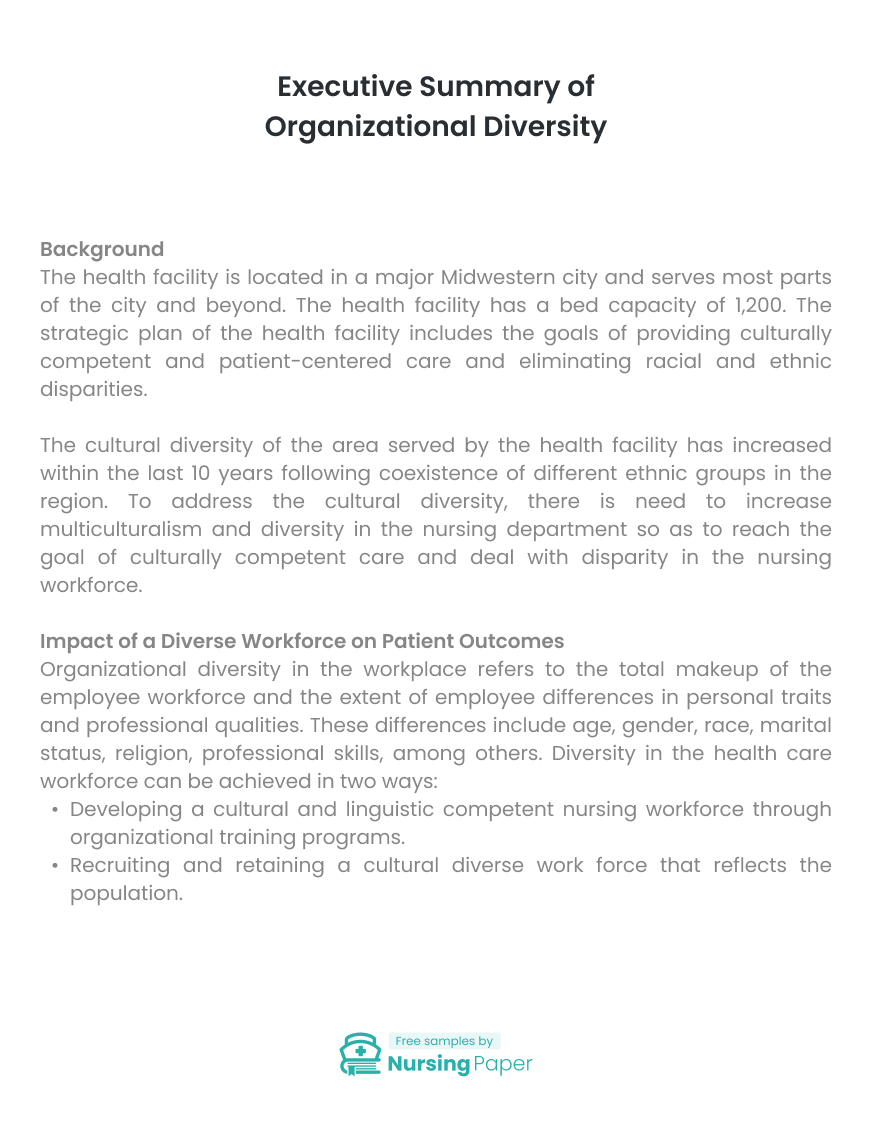
Executive Summary of Organizational Diversity
Background
The health facility is located in a major Midwestern city and serves most parts of the city and beyond. The health facility has a bed capacity of 1,200. The strategic plan of the health facility includes the goals of providing culturally competent and patient-centered care and eliminating racial and ethnic disparities.
The cultural diversity of the area served by the health facility has increased within the last 10 years following coexistence of different ethnic groups in the region. To address the cultural diversity, there is need to increase multiculturalism and diversity in the nursing department so as to reach the goal of culturally competent care and deal with disparity in the nursing workforce.


Impact of a Diverse Workforce on Patient Outcomes
Organizational diversity in the workplace refers to the total makeup of the employee workforce and the extent of employee differences in personal traits and professional qualities. These differences include age, gender, race, marital status, religion, professional skills, among others. Diversity in the health care workforce can be achieved in two ways:
- Developing a cultural and linguistic competent nursing workforce through organizational training programs.
- Recruiting and retaining a cultural diverse work force that reflects the population.
Based on systems approach, for a health care facility to become culturally competent, all the subsystems in the healthcare environment must interact (Weech, Elliot, Pradhan, et al. 2012). The healthcare must adapt the management and care-delivery subsystems to the needs of a diverse patient population.
Health care disparities arise due to cultural diversity in the client population. Research indicate that cultural competency in care delivery improves the overall hospital experience of a patient (Beach, Saha, and Copper, 2006). It also improves communication in general ensuring an attentive, tailored and a patient-centered care thus ensuring the best outcome of a patient. The main beneficiaries of cultural competent workforce are the minority population.

Lack of diversity in the nursing workforce is likely to result to poor nurse communications and staff responsiveness to a patient. A culturally competent nursing workforce with additional competency in linguistics ensures effective nurse communication and patient responsiveness. Studies indicate that communications between nurse and the patient determines the overall assessment and outcome (Elliot, Kanouse, and Edwards, 2009).
Interventions
The four current practices and policies of the health facility in addressing workforce diversity are:
- Diversity is part of the organization’s strategic plan.
- Cultural diversity and competency trainings, where the nursing department and other departments are offering diversity training on the different cultures of the community, new skills and multilingual competency.
- The recruitment policies aim at ensuring diversity. The current recruitment policy of the Nursing Department is recruiting more women and underrepresented minority.
- Diversity has been ensured in the top leadership positions in terms of gender diversity, representation of the minority groups and cultural diversity. In the nursing department, gender and cultural diversity have been implemented but not fully inclusive.
Most of the practices are in line with the recommendations by U.S Government Accountability Office (G.A.O) (2005) report on Diversity Management: Expert identified leading practices and agency examples.



Recommendations
To address the gaps between the organization practices and the best practices recommended by U.S G.A.O, evidence-based practices are recommended. The three evidence-based recommendations are:
- Crete a diversified work environment by providing different amenities for the culturally diversified workforce to ensure retention
- Establish a search committee to ensure effective recruitment and retention of the workforce.
- Create a leadership position such as Diversity Leadership Council to oversee diversity training programs and implementation of diversity plans and policies.
1. Beach, M.C, Saha, S, & Cooper, L.A. (2006). The Role and Relationship of Cultural Competence and Patient-centeredness in Health Care Quality. Washington D.C: Commonwealth Fund.
2. Elliott, M.N, Kanouse, D.E, & Edwards, C.A. (2009). Components of care vary in importance for overall patient-reported experience by type of hospitalization. Medical care, 47(8),842–849.
3. U.S. Government Accountability Office. (2005). Diversity management: Expert identified leading practices and agency examples. GAO-05-90. Washington, D.C.: G.A.O. Online report available at http://www.gao.gov/new.items/d0590.pdf
4. Weech-Maldonado, R., Elliott, M. N., Pradhan, R., Schiller, C., Hall, A., & Hays, R. D. (2012). Can Hospital Cultural Competency Reduce Disparities in Patient Experiences with Care? Medical Care, 50(0), S48–S55. http://doi.org/10.1097/MLR.0b013e3182610ad1



The download will start shortly.

The download will start shortly.
 Subject:
Nursing
Subject:
Nursing  Number of pages: 3
Number of pages: 3  Subject:
Medicine
Subject:
Medicine  Number of pages: 3
Number of pages: 3  Subject:
Health and Social Care
Subject:
Health and Social Care  Number of pages: 2
Number of pages: 2  Subject:
Nursing
Subject:
Nursing  Number of pages: 6
Number of pages: 6  Subject:
Health and Social Care
Subject:
Health and Social Care  Number of pages: 3
Number of pages: 3  Subject:
Health and Social Care
Subject:
Health and Social Care  Number of pages: 6
Number of pages: 6  Subject:
Medicine
Subject:
Medicine  Number of pages: 2
Number of pages: 2  Subject:
Health and Social Care
Subject:
Health and Social Care  Number of pages: 6
Number of pages: 6  Subject:
Health and Social Care
Subject:
Health and Social Care  Number of pages: 1
Number of pages: 1  Subject:
Health and Social Care
Subject:
Health and Social Care  Number of pages: 6
Number of pages: 6  Subject:
Health and Social Care
Subject:
Health and Social Care  Number of pages: 2
Number of pages: 2  Subject:
Health and Social Care
Subject:
Health and Social Care  Number of pages: 2
Number of pages: 2  Subject:
Nursing
Subject:
Nursing  Number of pages: 6
Number of pages: 6  Subject:
Health and Social Care
Subject:
Health and Social Care  Number of pages: 4
Number of pages: 4  Subject:
Health and Social Care
Subject:
Health and Social Care  Number of pages: 12
Number of pages: 12 
